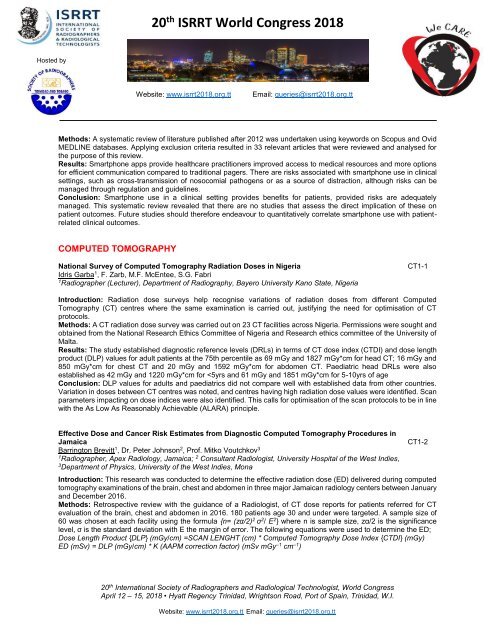Trinidad-and-Tabago-Congerss-Abstract-Book
Create successful ePaper yourself
Turn your PDF publications into a flip-book with our unique Google optimized e-Paper software.
20 th ISRRT World Congress 2018<br />
Hosted by<br />
Website: www.isrrt2018.org.tt<br />
Email: queries@isrrt2018.org.tt<br />
Methods: A systematic review of literature published after 2012 was undertaken using keywords on Scopus <strong>and</strong> Ovid<br />
MEDLINE databases. Applying exclusion criteria resulted in 33 relevant articles that were reviewed <strong>and</strong> analysed for<br />
the purpose of this review.<br />
Results: Smartphone apps provide healthcare practitioners improved access to medical resources <strong>and</strong> more options<br />
for efficient communication compared to traditional pagers. There are risks associated with smartphone use in clinical<br />
settings, such as cross-transmission of nosocomial pathogens or as a source of distraction, although risks can be<br />
managed through regulation <strong>and</strong> guidelines.<br />
Conclusion: Smartphone use in a clinical setting provides benefits for patients, provided risks are adequately<br />
managed. This systematic review revealed that there are no studies that assess the direct implication of these on<br />
patient outcomes. Future studies should therefore endeavour to quantitatively correlate smartphone use with patientrelated<br />
clinical outcomes.<br />
COMPUTED TOMOGRAPHY<br />
National Survey of Computed Tomography Radiation Doses in Nigeria<br />
Idris Garba 1 , F. Zarb, M.F. McEntee, S.G. Fabri<br />
1 Radiographer (Lecturer), Department of Radiography, Bayero University Kano State, Nigeria<br />
CT1-1<br />
Introduction: Radiation dose surveys help recognise variations of radiation doses from different Computed<br />
Tomography (CT) centres where the same examination is carried out, justifying the need for optimisation of CT<br />
protocols.<br />
Methods: A CT radiation dose survey was carried out on 23 CT facilities across Nigeria. Permissions were sought <strong>and</strong><br />
obtained from the National Research Ethics Committee of Nigeria <strong>and</strong> Research ethics committee of the University of<br />
Malta.<br />
Results: The study established diagnostic reference levels (DRLs) in terms of CT dose index (CTDI) <strong>and</strong> dose length<br />
product (DLP) values for adult patients at the 75th percentile as 69 mGy <strong>and</strong> 1827 mGy*cm for head CT; 16 mGy <strong>and</strong><br />
850 mGy*cm for chest CT <strong>and</strong> 20 mGy <strong>and</strong> 1592 mGy*cm for abdomen CT. Paediatric head DRLs were also<br />
established as 42 mGy <strong>and</strong> 1220 mGy*cm for


















